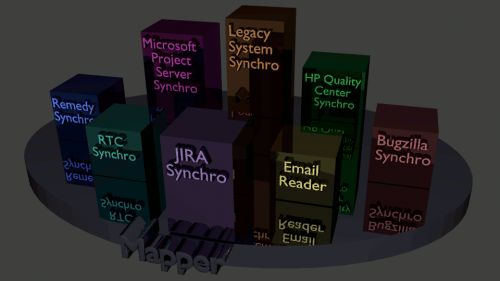Overview of System Synchronizer
System Synchronizer is the universal adjustable system that enables you to synchronize data amongst almost any information systems. Those can be both standard software solutions delivered to market by known vendors and homegrown systems which are results of the internal software development efforts.
The main positions which we have implemented when developing System Synchronizer:
- You can link different systems with each other and with different types of data and fields, providing either bi-directional or uni-directional data exchange
- It is possible define synchronization rules for describing the transformations of data in detail (another word, you can specify which data and in which way should be linked to each other as well as define the additional values transformations for them, if necessary). Synchronization rules can be easily changed, that is very important if your systems dynamically develop in time (to conform to changing the business conditions in the organization).
- Synchronizer can be easily adapted to any organization, taking into account the available park of systems and their characteristics in a specific business environment
- Synchronizer is very simple for deployment. When developing Synchronizer, we made the emphasis on the independence from third-party software! Customer has a freedom of choice which modules of Synchronizer use for deployment. They can be both stand-alone applications (only run them on the server), and Apache Tomcat applications, and IBM WebSphere Application Server applications. Additionally, there is no need to purchase and deploy any additional software designed, for example, for storage management, RDBMS, databases, etc.
- Synchronizer is a multi-platform solution because the most of the modules are built in Java. This fact allows you to deploy modules in Windows, in Linux, and so on. Only some modules that synchronize data for a specific system, created, for example, using Microsoft technologies, can be deployed only to Windows platforms.
- Synchronizer is an extensible solution because any complex integration system can be assembled from separate modules on the principles of mosaic. Just analyze your park of systems, identify the systems which you would like to synchronize, and deploy the required modules only. Next, order the development of specific modules for synchronization of the proprietary systems in your organization, if necessary.
- You can link the systems as one-to-many, when a single system is synchronized with several others. In this case, if you change the data in the first system then the data of the several linked systems will be changed in accordance to the predefined rules of synchronization.
- Monitoring the failures in real-time guarantees sending the Emails to administrators about all problems while Synchronizer processes the synchronization data. Detailed information about failures can also be obtained from the logs of modules with adjustable level of detalization.
- Synchronization for off-line systems ensures the accumulation of sync messages while the external system is turned off. But as soon the system is switched on again and started to operate normally, Synchronizer will process the postponed sync data in the same sequence as they were obtained.
- Synchronization of systems deployed in the demilitarized zones (DMZ). In this case it is possible to provide additional opportunities for the transfer of the sync data (which are the simple XML files including the information about the time of their inception) through any additional communication channels (for example, HTML, FTP, SSH, Email, mobile devices such as flash memories of various kinds, etc.). This ensures may be delayed but nevertheless the robust data synchronization between the systems.
- Support of multiple protocols when System Synchronizer modules are to remotely interact to each other. In brief, Synchronizer directly supports such protocols as SSH, FTP and HTTP data transfer types when transferring the data amongst the servers.
Some modules are so called gateways to external systems. They are used for bi-directional or uni-directional synchronization. The base module is Mapper which can transform the synchronization data on the fly in accordance to the synchronization rules, as well as encryption and decryption of the transmitted data, if necessary.
There is a set of ready-for-use standard gateways for some systems from known vendors which can be used when building a custom synchronizing solution based on Synchronizer modules:
- IBM Rational Team Concert gateway
- Atlassian JIRA gateway
- Email Server (POP3, MAPI) gateway
If your system isn't presented in this list then we can develop custom gateways for that one in a short time on the rules of custom software development.
Standard deployment of Synchronizer, as mentioned above, is a very easy procedure:
- Analyze the existing park of systems and determine the data to be synchronized amongst those systems
- Deploy the separate modules, each of which communicates directly with its own system involved into synchronization processes
- Deploy Mapper and configure the synchronization rules for all synchronization chains
- Monitor the synchronization processes among the systems in real time with the failure messages received by Email
© 2008-2023 Finecosoft.



